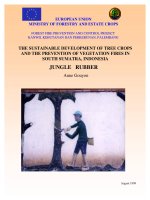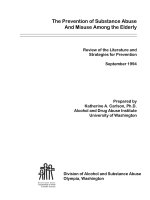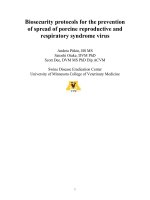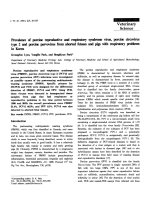Biosecurity protocols for the prevention of spread of porcine reproductive and respiratory syndrome virus ppt
Bạn đang xem bản rút gọn của tài liệu. Xem và tải ngay bản đầy đủ của tài liệu tại đây (3.14 MB, 17 trang )
1
Biosecurityprotocolsfortheprevention
ofspreadofporcinereproductiveand
respiratorysyndromevirus
AndreaPitkin,BS MS
SatoshiOtake,DVMPhD
ScottDee,DVM MSPhDDipACVM
SwineDiseaseEradicationCenter
UniversityofMinnesotaCollegeofVeterinaryMedicine
2
Acknowledgements
AmericanAssociationofSwineVeterinariansFoundation
MinnesotaRapidAgriculturalResponseFund
SwineDiseaseEradicationCenterPartners
PigImprovementCompany
Genetiporc
BoehringerIngelheim
PharmacologicalSolutions,Inc.
PfizerAnimalHealth
NovartisAnimalHealth
Noveko
PipestoneVeterinaryClinic
FairmontVeterinaryClinic
Clinique Demeter
SwineVetCenter
3
TableofContents
Topic Page
Introduction 4
VirusOverview 4
Routesofspreadandprotocolsofbiosecurity 414
Directroutesofspread
Pigsandsemen 45
Indirectroutes 613
Facilities 6
Needles 7
Transport 78
Personnel 89
Fomites 9
Insects 10
Aerosols 1113
Miscellaneous 1314
Pigmeat 13
Lagooneffluent 13
Carcassdisposal 13
Concludingremarks 14
Suggestedreading 1417
4
Introduction
Porcinereproductiveandrespiratorysyndrome(PRRS)isaneconomically
significantdiseaseofswinethathasbeen estimatedtoco sttheUSindustry
approximately$560millionayear.PreventingthespreadofPRRSVwithin andbetween
pigpopulationsisacritica lcomponentofafarm’sdiseasecontrol program.Toaidin
controllingthespreadofthisagent,thismanualprovidesasummaryof datafrom
exper imentsconductedfromourgroupattheUniversityofMinnesota thatwere
specifically designedtoidentifytheroutesofPRRSVtransmissionandtodevelop
protocolsof biosecurity toreducethisrisk. All protocolshavebeen,andcontinuetobe
validatedduringa nongoingexperimentthathasbeeninprocessoverthepast2yearsat
ourSwineDiseaseEradicationCenter(SDEC)productionregionmodel farm.The
authorsofthismanualcontinuetopracticetheseprotocolsandproceduresonadaily
basis;therefore,asofthiswritingourconfidenceintheirabilitytopreventPRRSV
spreadisveryhigh.Wehopethatswineveterinarianscan utilizet hisinformationtohelp
theirclientsdevelopeffectivebiosecurity programsforsustainablePRRScontrol.
VirusOverview
Priortodiscussinghowthevirusspreadsbetweenfarmsandwithinpopulationsof
pigs,itisimportanttounderstanditshostrangeandbiochemical characteristics. Based
ontheexcellentworkofseveralinvestigators, weknowthattheetiologicagentofPRRS,
porcinereproductiveandrespiratorysyndromevirus (PRRSV),isasinglestranded
positivesenseRNAvirusclassifiedintheorder Nidovirales,family Arteriviridaeand
genusArterivirus.PRRSVhasalsobeenshowntobeahostspecificvirus,capableof
infectingonly pigs.Therefore,no othermammalian, insectoravianspeciescanserveas
biologicalvectors ofthevirus. Inregardstoitscapabilityforsurvivaloutsideofthepig,
PRRSVissusceptibletohigh temperatures,changesinpH(<6and>7.65),and
prolongedexposuretoUVlightaswellaschemicalinactivation. WhilePRRSVcan
surviveformonthstoyearsw henfrozen(20degreesC),astemperatur eincreases,its
survivabilitydecreases.Forexample,theviruscansurvivefor6daysat21 degreesC,for
24hoursat37degreesCandforo nly20minutesat56degreesC. Inaddition,whenkept
moist,thevirusisviableoutto11days.
RoutesofSpread andProtocolsofBiosecurity
Directroutes(liveanimalsandsemen)
Asstated,pigsaretheonlyanimal capableofbecominginfect edwithPRRSV.
Onceinfectionoccurs, theviruscanbeshed from persistentlyinfect edpigsviablo od,
saliva,milkandcolostrum,urineandfeces,aswellascontaminatedsemen. Therefore,
purchasinggeneticmaterial fromnaïvesourcesthataremonitoredonaregularbasisis
critical.Vettovetcommunication toreviewt hecurrenthealthoftheherdpriorto
purchaseisrecommended,followedbyquarantineandtest ingofanimals.Thefollowing
areexamplesof protocolstoreducetheriskofPRRSVentrytofarmsviatheintroduction
ofgenetic material:
5
v Isolation
o Anisolation(quarantine)facilityisacriticalcomponent ofaPRRSV
biosecurityprogram.I solationfacilitiesshouldbelocatedgreaterthan 120
metersfromthebreedingherdandideally,offsite.Incomingstockshould
bekeptseparatefromresidentstockforaminimumof30days. Animals
shouldbemonitoreddailyforclinicalsignsbyfarmpersonnel.Theherd
veter inarian sho uldremaininclosecommunicationwiththeseedstock
supplier’sveterinarian duringthisperiodincasetheonsetofadisease is
suspectedinthesourcepopulationortheanimalsinquarantine.
v Testing
o Replacement stockshouldbebloodtested 2448hoursafterarrivaltothe
isolationfacility aswellas57daysprior totheirentrytothebreeding
herd.Onceinfected,PRRSVRNAcanbedetectedinthebloodstream24
hourspostinfection;therefore,testingofs amplesbyPCR is
recommendedtoenhancedetection of peracuteinfections. Samples
collectedlateintheisolationperiodcanalsobetestedby ELISAforthe
presenceofPRRSVantibodies.
o Withtheadventofthebloodswabtechnique,AIcenterscanproactively
monitor theirstatusviaPCRtestingofbloodfrombo arsbeingcollected
thatday,alongwiththeregulartestingofsemen,aga inbyPC R.Withthe
abilityofdiagnosticlabstoprovide“oneday turnaro und” ofPCRresults,
producersandveterinarianscan receivesemenvalidatedasPRRSV
negativeinrealtimeandsafelyintroduceittotheirherds.
Bloodtestingisoweangiltsinquarantine
Indirectroutes
PRRSVcanbemechanicallytransmittedinanumberofways.Thefollow ing
sectionwillreviewroutesoftransmiss ionandoutlinethebiosecurityprotocolsdesigned
tohelpprevent spreadviatheseroutes.
6
Facilities
Swinefacilitiesshouldbe managedusingallin,allout(AIAO)pigflow,thereby
reducingthespreadof PRRSVfromolder,infectedpigstoyounger,naïveanimals.In
conjunctionwithAIAOflow,itisimportanttoproperlysanitizethefacilities before
introducingsusceptibleanimals.E xamplesofthestepsrequiredtosanitizefacilitiesthat
housedPRRSVpositiveanimalsareasfollows:
v Allor ganicmaterial(feces,urine,feed,beddingandbodyfluids)shouldbe
completely removedandthesurfacespowerwashed.Specialattentionshou ld
bepaidtothegating,feeders,wat erers,slatsinthefloorsandany other“cracks
or crevices”wheresuchmaterialcouldbeharboredandmissed.
Removalofdebrisiscriticalforpropersanitationoffacilities
v Onceclean,anefficacious disinfectantshouldbeappliedthroughout thepen
area.Someexamplesof productsprovento beefficaciousagainstPRRSVare
quaternaryammonium+glutaraldehydemixtures(Synergize)andmodified
potassiummonopersulfate(Virkon).Theseproductsshouldbeappliedata
0.8%and1%concentration,respectively foraminimumof2hour s. The
applicationofd isinfectantsviaafoamerallowsforbettervisualizationof
whereproducthasbeenappliedandalsoprolongsthecontactbetween the
chemicalsandthesurfaces.
Applicationofdisinfectantsviaafoamerenhancestheireffectiveness
7
v Followingcleaning,thefacilitymustbeallowedadequatedowntimeordrying
timeafterdisinfection.Thisisthemostimportantstepinthesanitation
protocolforcompleteinactivationof thevirus.
Aproperlysanitizednurseryroom
Needles
Onceapigis infected,thequantity ofPRRSVint hebloodstreamtypically
reacheshighlevels.Therefore,injectionofconsecutiveanimalsusingaco ntaminated
needlecanresultinhematogenousspreadofthevirus.Toreducethisrisk, itis
recommendedtochangeneedlesbetweensowsduringthirdtrimesterinjectionsorutilize
“needlefree”technology.
Transportvehicles
PRRSVcanbespreadtosusceptibleanimalsfollowingcontactwithcontaminated
transportvehicles.Therefore,aswith facilities,stringentcompliancewith cleaning/
disinfection anddryingprotocolsiscriticalforsanitizingthetrailersof transportvehicles.
Potentialriskpointsinthecabofthetruck(pedals,floormats,etc)canbeeffectively
sanitizedusingdisinfectantspray,suchasLysol.Inregardstotrailers:
v Allor ganicmaterial(feces,urine,feed,bedding,etc)shouldberemoved.
Specialattention shouldbepaidto“hardtoreach”sites,suchascornersof
trailers,gatehinges/latches, etcwhere thismaterialcouldbeharbored.
ContaminatedtransportcanserveasasourceofPRRSVinfectionof naïvepigs
8
v Onceclean,efficaciousdisinfecta ntsshouldbeappliedtothevehicleusing
previouslydescribedconcentratio ns,periodsofcontactandmethodof
application.
Dryingisthemostimportantcomponentofatransportsanitationprogram
v Followingsanitation,thevehiclemustbeallowedadequatedryingtimeafter
disinfection.Aswithfacilities,thisisthemostimportantstepinthesanitation
protocoltocompletelyinactivatethevirus. Theuseof highvolumewarmair
candecreasetheamountoftimeneededfordrying.Thethermoassisteddrying
anddecontamination (TADD)s ystem developedbyPICisrecommendedto
achieveadryt railerintheshortestamounto ftime.Studieshaveindicatedthat
120minutesofhighvolumewarmairappliedviatheTADDmethodcan
effectivelyremovePRRSVfromcontaminatedsurfacesintransporttrailers.
Personnel
Thehands,coverallsandbootsofpersonnel canserveasmechanicalvehiclesfor
PRRSV.Belowareprotocolstoreducetheriskof PRRSVspreadviatheseroutes:
Entryprotocols
v Downtime
o Personnelshouldpracticeonenightofdowntimebeforeenteringafarm.
Researchhasshownthatextendedperiodsofdowntimearenotnecessary
forthisagent .
v Showerinshowerout
o Showerprotocolshavebeenproventosuccessfullydecontaminate
personnel contaminatedwithPRRSVpriortoentry.T heuseofsucha
procedure uponentrytothesystemeachdayisrecommended.
v Danishentrysystem
o Thissystemutilizesthechangingofcoverallsandbootsplusthewashing
ofhandsindesignatedareaspriortoenteringtheanimalairspaceandhas
beendemonstratedtobeveryeffective forreducingtheriskofPRRSV
spreadbypersonnelbetweens itesandbuildings.
9
Hands
v Gloves
o Theuseofglovescanhelppreventtransfero fvirus.Glovesshou ldbe
changedregularly,i.e.betweenlitters.
v Sanitizersandhandwas hing
o Frequenthandwashinganduseo fsanitizersthatcontain
iodinecan successfully removevirus fromhands.
Coveralls
v Coveralls
o Barnspecificcoverallsshouldbeavailableinallfacilities
andwashedroutinely. Disposablecoverallsarealsoan
option.
Boots
v Footbaths
o Useoffo otbathscangreatlyhelpreducetherisko fPRRSV
transferbetweengroupsofpigs.Bathss houldbechangedat
leasteveryday tomaintain disinfectantefficacy.Chlorinebleach,
quaternaryammonium +glutaraldehydemixture s (Synergize)and
modifiedpotassiummonopersulfate(Virkon)disinfect antsareeffective.
v Disposableor facilityspecificbootsshouldbeused.Bootsshouldneverleave
thefarmandshouldbepowerwashedtoremove fecesfromthesolesand
disinfectedroutinely.
Fomites
Contaminatedfomites,suchasfarmsuppliesandcontainerscanserveas
mechanicalvehiclesfor PRRSV.Therefore,allincomingsuppliess houldbedisinfected
andallowedaminimumof2hourscont acttimepriortointroductio n. “Doublebagging”
suppliesisanacceptablemethodforreducingtheriskofspread.Aspecificroomshould
beusedasadisin fectio nanddryingroomforfomites(D&Droom).Allincoming
suppliesshou ldbeplacedinthisroom,disinfectedonallsidesandallowedtheminimum
2hourco ntacttimepriortoentry. Thiscan bedoneusingacoldfogmister tocreatea
“fog”ofdisinfectant.After5minutesminimumcontacttime,thefomitesshouldbe
rotated, “fogged”ontheirdownsideforaminimumof5minutesandthenallowedto
remainintheroomforaminimumof2hours. Quaternaryammonium +glutaraldehyde
mixtures(Synergize)andmod ifiedpotassiummonopersulfate(Virkon)d isinfectants
dilutedto0.8%and1%respectively arerecommendedforuseinthissituation.
10
AerosolizingdisinfectantsinadesignatedD&Droomcanbeusefulwhensanitizing
incomingsupplies
Insects
Housefliesa ndmosqu itoescanserveasmechanicalvectorsofPRRSVandcan
transportthevirusatleast2.4kmfromaninfectedfarm.Thesiteofretentiono fthevirus
intheflyistheGItractandtherateofviraldecayovertimeisinfluencedbyquantity
ingestedandenvironmentaltemperature.InordertopreventspreadofPRRSVvia
insectsthefollowingstepsarer ecommended:
v Screens
o Allinlets,w indowsandareasthatcould beaccessedbyinsectsshouldbe
coveredwithscreens.I nordertomaintainproperventilation,screensmust
becleanedregularly.
Theuseofinsectscreenonsidewallinletshasbeendemonstratedtosignificantlyreduce
insectentry.
v Insecticides
o Pyrethrinbasedinsecticidesarehighlyeffectiveandarecommercially
availableaspremisesspraysorwashes.
v Insectbait
o Theuseofinsectbait,i.e.QuikSt rikestrips,isaneffectivemeansto
controlthenumberofinsects.
v Sitemanagement
o Cuttingthegrassandre movingweedssurroundingswinefacilitiesaswell
asremovalofstandingwaterarealso recommendedforeliminatinginsect
breed ingareas.
11
Aerosols
v AirbornespreadofPRRSVappearstobeisolatespecific.Asnewhighly
pathogenicisolatesofPRRSVhaveemerged,such asMN184and118 2,
theirabilitytotravellongdistancesviaaerosolsappearstohaveincreasedin
contrasttoearlieriso lates.Recentresearchhasdemonstratedtheabilityof
infectiousPRRSVtobe transmittedby aerosolsoveradistanceof120meters.
However,preliminaryresultsfromexperimentalstudiesalongwithfieldreports
indicatethataerosoltr ansmission ofPRRSVcanoccuratleastupto3.3km(2
miles)ormore (Deeetal,manuscriptinpreparation). Therefore,asisolates
adapt,somustthebiosecurityprotocolsif thereisanychanceofproviding
sustainablediseasecontrol.
v ToreducetheriskofairbornespreadofPRRSV, theadaptationof filtration
systemstoswinefacilitieshascomeabout. Theseearlysyste mshaveutilized
MERV16(95%DOP@ >0.3microns)filtersand resultsoverthelast23
yearshavebeenencour aging. Installationofanairfiltrationsystemdepends
upontheindividualpro ducer’sbudget,thelocationofthesite(highswine
density vs.lowdensity),thelevelofacceptableriskandtypeof production
system,i.e.seedstockorco mmercial.Filters canbeinstalledo neoftwoways,
eitherintheatticthroughinsertionoffiltersintotheceilinginletso rintheform
ofafilterbankprecedingthecoolcellpad.
AsingleMERV16filter Abankof6MERV16f ilters
If anairfiltrationsystemisinstalledinabuildingwhichis ventilatedusing
negativepressure,all areasofthebarnthatcouldserveaspotentialairleaksneedtobe
sealed.Thisincludescracksinthebuildingandaroundwindowsanddoors,shuttersand
idlefans.Inaddition,“doubledoor”entry/exitsystemsmustbeinstalledtoprevent
potentiallycontaminatedairfromenteringtheanimalairspaceathighriskpoints,such
12
aspersonnelentryways,live/deadanimalloadoutrooms,D&Drooms,etc.Theprotocol
ofthedoubledoorsystem involvestheuseofachamberandspecificprocedures:
v Thechambermustcont ainanexternaldoorandaninternaldoorwhich
communicateswiththeanimalairspace.Whenenteringfrom theoutside,the
externaldoorisopened,personnelorpigsenterachamberandthedooris
closed. Thesameprocessoccurswhenenter ingthechamberfro mtheinsideo f
thebuildingviatheinternaldoor.
Anexternalviewofthedoubledoorchamber
v Thechambermustalsocontainanexhaustfan designedtoclearall theairin
theroom inacert aintimeframe,i.e.15minutes,dependingonroomvolume.
Toaidinevacuatingcontaminatedair, “clean”airisdrawnintothechamber
viaabaffleinletfroman anteroom orananimalairspacewithinthefacility.
Onceanimals/personnelhaveenteredandbothdoorsareclosed,thefanis
turnedonandallowedtorunforthedesignatedtimeperiod.
Aviewoftheexhaustfan withinthechamber
13
v Oncetheevacuationperiodisover, theinteriordoorcanbeopenedallowing
personnel/pigstoenterinsidethefacility orleavethefacilityviatheexternal
door.
Aviewofthebaffleinletinthechamber
Note:Thedoubledoorsystem hasbeenextensivelytestedandfoundtobehighly
efficaciousat preventingt heintroductionofvirusviacontaminatedaerosols,bothatthe
SDECpro ductionregionmodelandonfilteredcommercialfarms. Itisimportanttowork
withanexperiencedengineertodeterminetheproperfansizeandevacuationperiod
accordingtothevolumeofeachchamberonthefarm.
Miscellaneous
OtherfactsregardingPRRSVtransmissionwhichmaybeimportantforproducers
toconsiderwhendevelopingtheirfarmspecificbiosecurityprotocolsareasfollows:
Pigmeat
Meatfrominfectedpigscanharbor PRRSVforatleast7daysat4degreesCand
formonthswhenfrozenat20degreesC.Therefore,freshorfrozenpigmeatsho uldnot
beallowedintoaswinefacilityatanytime.
Lagooneffluent
PRRSVcansurviveinlagooneffluentforup to3daysat20degreesCandfor7
daysat4degreesC. ContactwithPRRSVpositiveeffluentcanserveasasour ceof
infectiontonaïvepigs.Therefore,producersthatutilizerecycledlagoonwaterintheir
wastemanagementprotocolsmaybeathigherriskforexternalvirusintroductionthan
thosewhousedeeppits.
Carcassdisposal
PRRSVcanbeinactivatedthroughtheprocessofco mpostingorincinerat ing
carcasses.Therefore,onlythesemethodsshouldbeapplied.Allowingrenderingtrucksto
driveontofarmpremisesshouldbeavoidedatalltimes.
14
IncinerationisaneffectivemeansofdisposingofPRRSVpositivecarcasses
Concludingremarks
Basedonourexperienceoverthepast2years,underwellcontrolledfield
conditionstheprotocolssummarizedinthisdocumentarehighly effectiveatpr eventing
PRRSVspreadbetweenpopulationsofpigs. Obviously,perso nnelcomplianceisthekey
tosuccessfulimplementationofsuchprocedures.Veterinarianscanplayanimportant
role,notonly astheteammemberwhodeliverssciencebasedbiosecuritytothefarmbut
alsoasateachertoeducatepersonnelandanauditortoinsurecomplianceismaximized.
Bypracticingtheaboveprotocols,itishopedthatproducerscaneffectivelyreducethe
riskofPRRSVintroductiontotheirherdsand maintainahighstandardofswinehealth
andproductionontheirfarms. Inaddition,broadapplicationofacomprehensivePRRSV
biosecurityprogram acrossfarms mayaidinreductionofviralspreadwithinaregion,
enhancingthesuccessofareabasedcontrolanderadicatio nprograms.
Suggestedreading
Theinformation onPRRSVtransmissionandbiosecurity summar izedaboveisbasedon
dataderivedfrom thefollowingpeerreviewedstudiespublishedbyourgroup:
Airbornesp read
PitkinAN,DeenJandDeeSA. Useofaproductionregionmodeltoassesstheairborne
spreadofporcinereproductiveandrespiratorysyndromevirus.VetMicrobiol(Inpress).
ChoJG,DeeSA,DeenJ,GuedesA,TrincadoC,FanoE,JiangY,FaabergK,CollinsJE,
MurtaughMPandJooHS.Theinfluenceofanimalage,bacterialcoinfectionand
porcinereproductiveandrespiratorysyndromevirus (PRRSV)isolatepathogenicityon
virusconcentrationinindividualpigs. AmJVetRes2006;67:489493
ChoJG,DeeSA,DeenJ,TrincadoC,FanoE,MurtughMP,CollinsJEandJooHS.An
evaluationofdifferentvariablesonthesheddingofporcinereproductiveandresp iratory
syndromevirusinaerosols.CanJVetRes2006;70:297301.
ChoJG,DeeSA,DeenJ,MurtaughMP,andJooHS.Anevaluationo fisolate
pathogenicityonthetransmissionofporcinereproductiveandrespiratorysyndromevirus
byaerosols.CanJVetRes2007;71:2327.
15
DeeSA,DeenJ,CanoJP,BatistaL,andPijoanC.Furtherevaluationofalternativea ir
filtrations ystemsforreducingthetransmissionofpor cinereproductiveandrespiratory
syndromevirusbyaerosols.CanJVetRes2006;70:168175.
DeeSA,DeenJ,BatistaL,andP ijoanC.Anevaluat ionofalternativesystemsfor
reducingthet ransmissionofporcinereproductiveandrespiratorysyndromevirusby
aerosols.CanJVetRes2006;70:2833.
DeeSA,BatistaL,DeenJ,andPijoanC.Anevaluationofanairfiltrationsyste mfo rthe
preventionofporcinereproductiveandrespiratorysyndromevirustransmissionby
aerosolsCanJVetRes2005;69:293298.
Fomitesandpersonnel
PitkinAN,DeenJandDeeSA. Furtherassessmentoffomitesandpersonnelasvehicles
forthemechanicaltransportand transmissionofporcinereproductiveandrespiratory
syndromevirus.CanJVetRes(Acceptedforpublicatio n).
DeeSA,DeenJ,RossowKD,EliasonR,MahlumC,OtakeS,JooHS,andPijoanC.
Mechanicaltransmissionofporcinereproductiveandrespiratorysyndromevirus
throughoutacoordinatedsequenceofeventsduringwarmweather.CanJVetRes2003.
67:1216.
DeeSA,DeenJ,RossowKD,Mahlu mC,Ot akeS,JooHSandCPijoan.Mechanical
transmissionofporcinereproductiveandrespiratorysyndromevirusthroughout a
coordinatedsequenceofeve ntsduringcoldweather .CanJVetRes2002.66:232239.
DeeSA,DeenJ,andPijoanC.Anevaluationoffourinterventionstrategiestoprevent
mechanicaltransmissionofpo rcinereproductiveandrespiratorysyndromevirus.CanJ
VetRes2004.68:1926.
OtakeS,DeeSA,Rosso wKD,DeenJ,JooHS,MolitorTW,andPijoanC.Transmission
ofporcinereproductiveandrespiratorysyndromevirusbyfomites(bo otsandco veralls).
SwineHealthProd2002. 10(2):5965.
OtakeS,DeeSA,Rosso wKD,DeenJ,JooHS,MolitorTW,andPijoanC.Transmission
ofPRRSVbyneed les.VetRec2002.150,114115.
Insects
PitkinAN,OtakeS,DeenJ,MoonRD, DeeSA.Furtherassessmentofhouseflies(Musca
domestica)asvectorsforthemechanicaltranspo rtandtransmissionofporcine
reproductiveandrespiratory syndromevirusunderfieldconditions.CanJVetRes
(Acceptedforpublicatio n).
SchurrerJA,DeeSA,MoonRD,DeenJ,andPijoanC.Anevaluationof3intervention
strategiesforthecontrolofinsectsonacommercialswinefarm SwineHealthProd
2006;14:7681.
16
SchurrerJA,DeeSA,MoonRD,MurtaughMP,FinneganCP,DeenJ,KleiboeckerSB,
andPijoanC.Retentionofingestedporcinereproductiveandrespiratorysyndromevirus
inhouseflies.AmJVetRes2005;66:15171525.
SchurrerJA,DeeSA,MoonRD,Rosso wKD,MahlumC,MondacaE,OtakeS,FanoE,
CollinsJE,andPijoanC. Spatialdispersalofpo rcinereproductiveandrespiratory
syndromeviruscontaminatedfliesfollowingcontactwithexperimentallyin fect edpigs
AmJVetRes2004.65:12841292.
OtakeS,DeeSA,MoonRD,Rossow KD,TrincadoC, andPijoanC.Studiesonthe
carriageandtr ansmissionofporcinereproductiveandrespiratorysyndromevirusinan
individualhousefly(Muscadomestica,Linnaeus).VetR ec2004.154:8085.
OtakeS,DeeSA,MoonRD,Rossow KD,TrincadoC andPijoanC.Evaluationof
mosquit oes(Aedesvexans,Meigen)asbiologicalvector so fporcinereproductiveand
respiratorysyndromevirus.CanJVetRes2003.67:265270.
OtakeS,DeeSA,MoonRD,Rossow KD,TrincadoC, FarnhamM,andPijoanC.
Survivalofporcinereproductiveandresp iratorysyndromevirusinhouseflies(Musca
domesticaLinnaeus)CanJVetRes2003.67:198 203.
OtakeS,DeeSA,Rosso w KD,MoonRD,TrincadoC,andPijoanC.Transmissionof
porcinereproductiveandrespiratorysyndromevirus byhouseflies,(Muscadomestica
Linnaeus).VetRec2003.152:7376.
OtakeS,DeeSA,Rosso wKD,MoonRD,andPijoanC.Transmissionofporcine
reproductiveandrespiratorysyndromevirusbymosquitoes(Aedesvexans).CanJVet
Res2002.66:191195.
OtakeS,DeeSA,JacobsonL, TorremorellM,andPijoanC.Evaluat ionofaerosol
transmissionofporcinereproductiveandrespiratorysyndromevirusunderfield
conditions.VetRec 2002150,804808.
Transport
DeeSA,TorremorellM,ThompsonR,Ca noJP,DeenJ,andPijoanC.Evaluationofthe
thermoassisteddryinganddecontaminationsystem(TADD)forthesanitationoffull
sizetransportvehiclescont aminatedwithporcinereproductiveandrespiratorysyndrome
virus.SwineHealthProd2007 ;15:1218.
DeeSA,DeenJa ndPijoanC.Anevaluationofanindustrybasedsanitationprotocol for
fullsizePRRSVcontaminatedtransportvehicles.SwineHealthProd2006;14:307311.
DeeSA,DeenJ,andPijoanC.Anevaluationofanindustry–basedsanit ationprotocolfor
PRRSVcontaminatedtransportvehicles.SwineHealthProd2006;14:126132.
17
DeeSA,DeenJa ndPijoanC.Evaluationofdisinfectantsforthesanitationofporcine
reproductiveandrespiratorysyndromeviruscontaminatedtransportvehiclesatcold
temperatures.CanJVetRes2005;69:6470.
DeeSA,TorremorellM,DeenJ,ThompsonBandPijoanC.Anevaluationofthe
ThermoAss isted DryingandDecontamination(TADD)systemfor theeliminationof
porcinereproductiveandrespiratorysyndromevirusfromco ntaminatedlivestock
transportvehicles.Can JVetRes2005;68:208214.
DeeSA,DeenJ,BurnsD,DouthitGandPijoanC.Anassessmentofsanitatio nprotocols
forcommercialtransportvehiclescontaminatedwithporcinereproductiveandrespiratory
syndromevirus.CanJVetRes2004.68:208214
DeeSA,DeenJ,OtakeS,andPijoanC.Anassessmentoftransportvehiclesasasource
ofporcinereproductiveandrespiratorysyndromevirustransmissiontosusceptiblepigs.
CanJVetRes2004.68:124 133.
Miscellaneous
CanoJP,DeeSA,DeenJ,FinneganC,MurtaughMPandPijoanC.Anexploratorystudy
toevaluatethesurvivalofporcinereproductiveandrespiratory syndromevirusinnon
processedpigmeat.VetRec2007,160:907908.
DeeSA,MartinezBCandClantonCJ.Survivalandinfectivityofporcinereproductive
andrespiratorysyndromevirusinswinelagooneffluent .VetRec 2005;156,5657.
TrincadoC,DeeSA,RossowKD,HalvorsonD,andPijoanC.Transmissionofporcine
reproductiveandrespiratorysyndromevirusbynonporcinevectors:Areevaluationof
Mallardducks.VetRec 2004.154:233237.
BatistaL, DeeSA,RossowKD,Po lsonDD, XiaoZ,OlinM,MolitorTWMurtaughMP
andPijoanC.Detectionofporcinereproductiveandrespiratorysyndromevirusinpigs
withlowpositiveornegativeELISAs/pratios.VetRec2004.154:2526.
ChoJGandDeeSA.Porcinereproductiveandrespiratorysyndrome.Theriogenology,
2006;66:655662.









